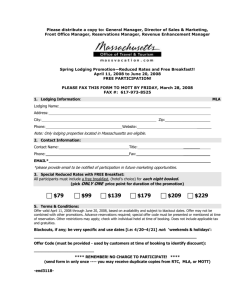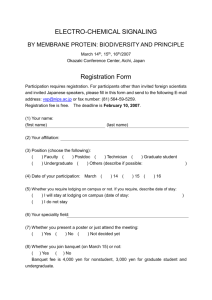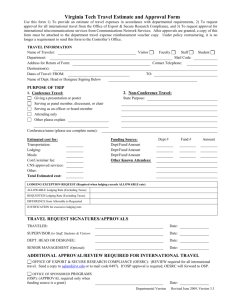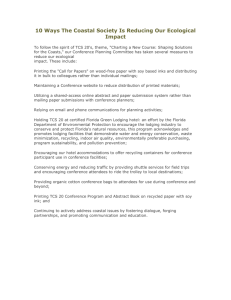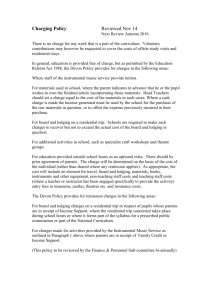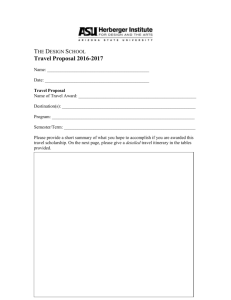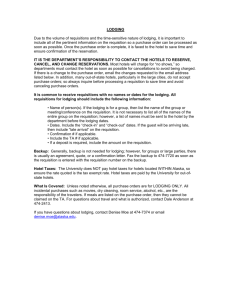Lodging Services Career Pathway - Home Economics Careers and
advertisement
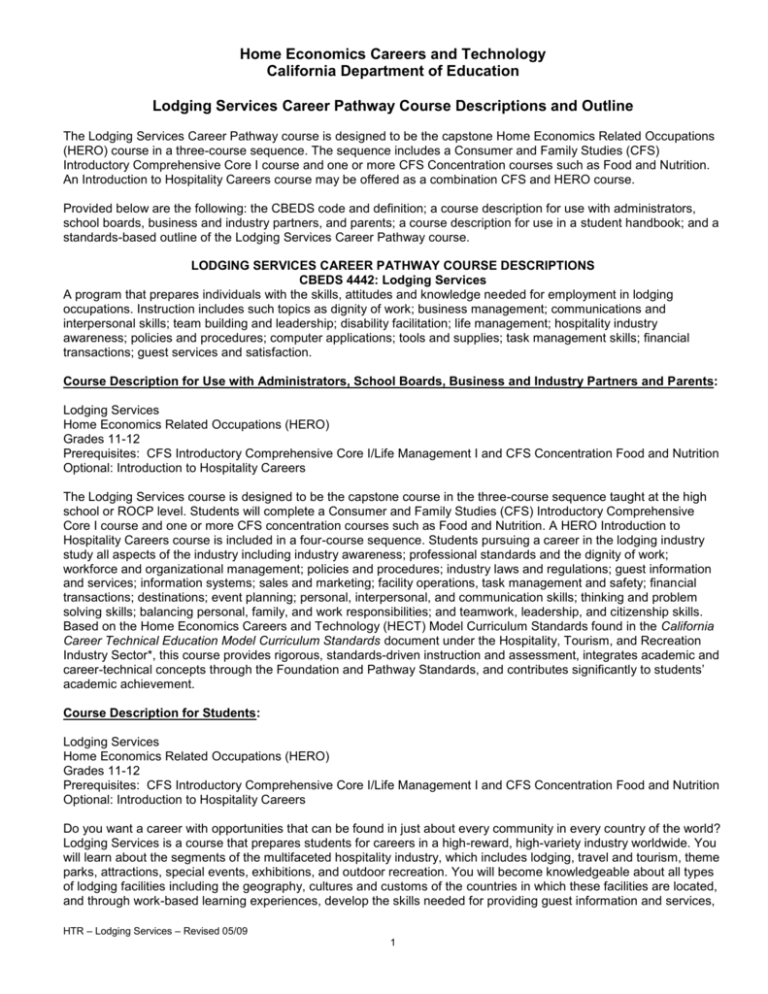
Home Economics Careers and Technology California Department of Education Lodging Services Career Pathway Course Descriptions and Outline The Lodging Services Career Pathway course is designed to be the capstone Home Economics Related Occupations (HERO) course in a three-course sequence. The sequence includes a Consumer and Family Studies (CFS) Introductory Comprehensive Core I course and one or more CFS Concentration courses such as Food and Nutrition. An Introduction to Hospitality Careers course may be offered as a combination CFS and HERO course. Provided below are the following: the CBEDS code and definition; a course description for use with administrators, school boards, business and industry partners, and parents; a course description for use in a student handbook; and a standards-based outline of the Lodging Services Career Pathway course. LODGING SERVICES CAREER PATHWAY COURSE DESCRIPTIONS CBEDS 4442: Lodging Services A program that prepares individuals with the skills, attitudes and knowledge needed for employment in lodging occupations. Instruction includes such topics as dignity of work; business management; communications and interpersonal skills; team building and leadership; disability facilitation; life management; hospitality industry awareness; policies and procedures; computer applications; tools and supplies; task management skills; financial transactions; guest services and satisfaction. Course Description for Use with Administrators, School Boards, Business and Industry Partners and Parents: Lodging Services Home Economics Related Occupations (HERO) Grades 11-12 Prerequisites: CFS Introductory Comprehensive Core I/Life Management I and CFS Concentration Food and Nutrition Optional: Introduction to Hospitality Careers The Lodging Services course is designed to be the capstone course in the three-course sequence taught at the high school or ROCP level. Students will complete a Consumer and Family Studies (CFS) Introductory Comprehensive Core I course and one or more CFS concentration courses such as Food and Nutrition. A HERO Introduction to Hospitality Careers course is included in a four-course sequence. Students pursuing a career in the lodging industry study all aspects of the industry including industry awareness; professional standards and the dignity of work; workforce and organizational management; policies and procedures; industry laws and regulations; guest information and services; information systems; sales and marketing; facility operations, task management and safety; financial transactions; destinations; event planning; personal, interpersonal, and communication skills; thinking and problem solving skills; balancing personal, family, and work responsibilities; and teamwork, leadership, and citizenship skills. Based on the Home Economics Careers and Technology (HECT) Model Curriculum Standards found in the California Career Technical Education Model Curriculum Standards document under the Hospitality, Tourism, and Recreation Industry Sector*, this course provides rigorous, standards-driven instruction and assessment, integrates academic and career-technical concepts through the Foundation and Pathway Standards, and contributes significantly to students’ academic achievement. Course Description for Students: Lodging Services Home Economics Related Occupations (HERO) Grades 11-12 Prerequisites: CFS Introductory Comprehensive Core I/Life Management I and CFS Concentration Food and Nutrition Optional: Introduction to Hospitality Careers Do you want a career with opportunities that can be found in just about every community in every country of the world? Lodging Services is a course that prepares students for careers in a high-reward, high-variety industry worldwide. You will learn about the segments of the multifaceted hospitality industry, which includes lodging, travel and tourism, theme parks, attractions, special events, exhibitions, and outdoor recreation. You will become knowledgeable about all types of lodging facilities including the geography, cultures and customs of the countries in which these facilities are located, and through work-based learning experiences, develop the skills needed for providing guest information and services, HTR – Lodging Services – Revised 05/09 1 Lodging Services Career Pathway Course Descriptions and Outline management and operation of facilities, reservations; and planning and coordinating events. Take this first step to success in the lodging industry through this course! *Refer to the Home Economics Careers and Technology Education (HECT) Consumer and Family Studies Standards Implementation Resource Guide, Grades 7-12 for the standards detail. Note: If this course has been approved for articulation or credit with a community college, California State University, or University of California, a statement should be included under each course description. If this course has been approved to meet UC/CSU “a-g” entrance requirements, a statement should be included under each course description. HTR – Lodging Services – Revised 05/09 2 Lodging Services Career Pathway Course Descriptions and Outline Home Economics Related Occupations LODGING SERVICES CAREER PATHWAY COURSE OUTLINE (Refer to the legend at the end of the outline) Program Content I. Standards/Standards Subcomponents Major Aspects of the Lodging Services Industry A. Segments of the Lodging Industry 1. Full-Service Hotels a. Convention Hotels b. Luxury Hotels c. Resort Hotels d. Extended-Stay Hotels e. Condominiums 2. Limited-Service Properties a. Limited-Service Hotels b. Budget Hotels 3. Specialty Accommodations a. Conference Centers b. Lodges c. Bed and Breakfast Operations d. Hostels e. Campgrounds 4. Institutional Housing a. Institutions b. Senior Housing Facilities B. Functions and Roles of the Industry Segments 1. Core Elements 2. Supporting Industries C. Economic Impact and Contributions of the Industry Segments 1. Local 2. State 3. National 4. International D. Economic Trends 1. Relationship Between Industry and Economic Trends 2. The Effect of Trends on Careers a. Technological Developments b. Societal Trends c. Need for Lifelong Learning E. Scope of Career Opportunities in the Industry 1. Variety of Career Paths 2. Qualifications, Aptitudes, Knowledge, Skills, and Abilities 3. Working Conditions of Various Careers 4. Requirements for Education, Training, and Licensure F. Career Planning and Management 1. Career Interests 2. Career Pathways 3. Postsecondary Options 4. Employment Strategies G. Career Advancement 1. Professional Growth and Development 2. Professional Organizations, Industry Associations, and Organized Labor HTR – Lodging Services – Revised 05/09 3 C7.1 C1.5 C1.2 F2.7, F 3.5, C1.4 F3.1, F3.2, C1.1, C1.3 F2.4, F3.3, F3.5, F3.6 F2.7, F3.4, F3.5 Lodging Services Career Pathway Course Descriptions and Outline II. Professional Standards/Dignity of Work A. Workplace Ethics 1. Need for a Code of Ethics 2. Ethical Behaviors 3. Legal Behaviors 4. Role of Personal Integrity B. Professionalism 1. Components of Professionalism 2. Professional Behaviors 3. Confidentiality 4. Appropriate Grooming, Clothing, and Personal Hygiene C. Quality of Work 1. Interdependence and Importance of Jobs 2. Effect of On-the-Job Decisions and Actions 3. Need for Responsibility and Flexibility D. Employer and Employee Rights and Responsibilities III. Workforce and Organizational Management A. Outcomes of Effective Management and Business Procedures 1. Profitability 2. Productivity 3. Workplace Atmosphere 4. Consumer and Guest Satisfaction 5. Business Growth B. Workforce Management Strategies 1. Types and Effective Use of Management Strategies a. Shared Responsibilities b. Negotiation c. Planning d. Decision-Making 2. Ways the Mission and Goals Affect Operations 3. Effect on Employees’ Actions, Attitudes, and Productivity C. Appropriate Business Procedures 1. Use and Interpretation of Business Plans 2. Use of Appropriate Technology in the Industry Segments a. Tools for Budgeting, Recordkeeping, and Correspondence b. Spreadsheets for Payroll and Inventories IV. Industry Laws and Regulations A. Identification of Laws, Regulations, and Agencies 1. Employer Established 2. Local 3. State 4. Federal B. Impact of Laws and Regulations 1. Requirements of CAL/OSHA 2. The Americans with Disabilities Act (ADA) 3. Wage and Hour Laws 4. Tenant Status 5. Accommodation of Minors C. Complying with Laws and Regulations 1. Employer Rights, Responsibilities, and Procedures 2. Employee Rights, Responsibilities, and Procedures D. Enforcement by Regulatory Agencies HTR – Lodging Services – Revised 05/09 4 F8.2, F8.3 F7.1 F7.2, F7.3, F7.4 F6.1 C2.1 C2.2 F4.2, F4.4, C2.1 F6.1, C2.4 F6.1, C2.4 F6.1, C2.4 F8.1 Lodging Services Career Pathway Course Descriptions and Outline V. Policies and Procedures A. Purposes of Workplace Policies and Procedures 1. Commonalities 2. Legal Implications B. Safety and Emergency Procedures 1. Employer/Employee Responsibilities 2. Safe Work Practices and Conditions 3. Infectious Disease Control 4. First-Aid and CPR Procedures 5. Emergency Training C. Security Procedures 1. Safeguarding Company and Customer Assets 2. Confidentiality of Customer Information 3. Control of Keys D. Customer and Employee Accommodations 1. Disability Facilitation 2. Minors 3. Workplace Diversity 4. Harassment 5. Discrimination VI. Effective Customer Services A. The Concept of Exceptional Customer Service 1. Importance to the Establishment’s Success 2. Ways to Anticipate Customer Needs, Desires, and Interests 3. Ways to Exceed Customer Expectations B. Effective Customer Service Strategies 1. Roles of Management and Employees 2. Ways to Meet the Needs of Diverse Customers a. Culturally Diverse b. Generationally Diverse 3. Positive, Responsive, and Professional Interactions C. Responding to Customer Complaints 1. Common Customer Complaints 2. Customer Service Solutions a. Prevention b. Resolution VII. Sales and Marketing Strategies A. Major Market Segments 1. Business 2. Conventions and Meetings 3. Leisure 4. Budget 5. Long-Stay 6. Special B. Basic Marketing Principles and Procedures 1. Ways to Maximize Revenues 2. Role of Supply and Demand 3. Applications to Targeted Audiences C. Analysis of Marketing Strategies 1. Promotional Selling 2. Upgrading 3. Publicity 4. Effects on Profit C2.3 F6.1, C2.3 C2.3 C2.5 C3.1, C3.2, C3.3 F2.5, F2.6, C3.5, C3.6 F2.6, C3.4 C4.3 C4.1, C4.4 C4.2 HTR – Lodging Services – Revised 05/09 5 Lodging Services Career Pathway Course Descriptions and Outline D. Long-Term Guest and Client Group Relationships 1. Development Strategies 2. Maintenance Strategies VIII. Technological Resources A. Technology in the Industry 1. Technological Advances in the Industry 2. Use of Technological Resources a. Property Management Systems b. Electronic Key Systems c. Wireless Communication Devices d. Use of the Internet for Operations 3. Influences of Current and Emerging Technology 4. Use of Appropriate Technology C4.5 F4.1, F4.2, F4.3, F4.4 IX. Systems Operations and Maintenance A. Facilities Management 1. Contributions of Departments to Economic Success 2. Relationships to Profit and Loss a. Cost of Breakage, Theft, and Supply Use b. Decisions for Repair and Replacement 3. Planning Work Schedules B. Operational Procedures 1. Maintaining Inventories 2. Ordering Equipment and Supplies 3. Storing and Restocking Supplies 4. Use of Technology for Operational Procedures C. Cleaning and Maintenance 1. Types of Materials and Supplies Used 2. Identification of Hazardous Materials 3. Use of Material Safety Data Sheets (MSDSs) 4. Cleaning, Maintenance, and Repair Procedures a. Cleaning Rooms, Public Areas, and Offices b. Sanitizing, Disinfecting, and Disposing of Waste 5. Importance of Preventative Maintenance X. Principles of Sanitation and Safe Food Handling A. Maintaining Sanitary Conditions 1. Standards in Personal Grooming and Hygiene 2. Local, State, and Federal Sanitation Regulations 3. Food Contamination: Types, Causes, and Prevention 4. Procedures for Sanitizing Work Surfaces and Equipment 5. Safe Use of Chemicals, Sanitizers, and Cleaning Agents B. Safe Food Handling 1. Hazard Analysis and Critical Control Points (HACCP) 2. Food Receiving, Storage, Production, Service, and Clean-Up 3. Use of Flowcharts from Receiving Ingredients to Preparation and Service 4. Causes and Prevention of Food–borne Illnesses 5. Purpose and Process of Required Certification (ServSafe) XI. Financial Transactions A. Handling Financial Transactions 1. Accurately 2. Professionally C5.1, C5.5, C5.6 F4.2, F4.4, C5.4 F6.2, C5.2, C5.3 F6.1, F6.2, B3.1, B3.2, B3.3, B3.4 B3.3, B3.5, B3.6 C6.3 HTR – Lodging Services – Revised 05/09 6 Lodging Services Career Pathway Course Descriptions and Outline B. C. D. 3. Ethically Cash Transactions 1. Balancing Cash 2. Handling Cash Control 3. Converting Currency 4. Identifying Counterfeit Currency Noncash Transactions 1. Credit, Debit, and ATM Cards 2. Money Orders 3. Personal Checks 4. Coupons 5. Discounts 6. Online Transactions Impact of Identity Theft on the Industry C6.1 C6.2 C6.4 XII. Lodging Establishment Organization and Functions A. Lodging Establishment Organization 1. Internal Hierarchy 2. Departmental Interrelationships B. Functions of the Lodging Business 1. Front Office 2. Housekeeping 3. Purchasing and Receiving 4. Management 5. Marketing and Sales 6. Human Resources 7. Accounting 8. Security and Safety 9. Engineering D. Required Duties of Various Positions E. Types of Food Service at Lodging Facilities XIII. Food and Beverage Service A. The Principle of mise en place B. Duties of Various Positions 1. Host/Hostess, Wait Staff, Bus Person, and Others 2. Opening and Closing 3. Change of Shift 4. Preparatory Work 5. Coordinating and Assembling Food Orders a. Accurate Portioning b. Plating and Garnishing C. Safe, Efficient, and Proper Service Procedures 1. Setting Tables 2. Serving Tables 3. Maintaining Tables 4. Busing Tables D. Customer Service Techniques 1. Greeting, Seating, and Presenting Menus 2. Explaining Menu Items 3. Taking Customer Orders 4. Writing Food and Beverage Orders 5. Relaying Orders to the Kitchen a. Manual Systems b. Automated Systems HTR – Lodging Services – Revised 05/09 7 C7.2 C7.3 C7.3 C7.4 B9.1 B9.2 B9.3 F2.5, F2.6, B9.4, B9.5 Lodging Services Career Pathway Course Descriptions and Outline 6. Preparing and Presenting Checks 7. Processing Payments a. Cash Transactions b. Non-Cash Transactions XIV. Global and Domestic Physical and Cultural Geography A. Effects on World Travel and Tourism 1. Physical Geography 2. Culture 3. Politics 4. The Economy B. Destinations for Worldwide Travel and Attractions C. Types of Information Needed by International Travelers 1. Physical Geography a. Countries on Each Continent b. Major Mountain Ranges c. Oceans, Seas, and Rivers 2. Differences in Time Zones, Climates, and Seasons 3. International Date Line 4. Rights and Responsibilities 5. Laws 6. Cultures and Customs of Counties and Regions a. Major Languages b. Typical Food and Beverages c. Typical Etiquette and Behaviors d. Cultural Resources e. Customs 7. Attractions and Events Unique to Destinations XV. Event Planning A. Essential Event Planning Procedures 1. Planning 2. Promotion 3. Publicity 4. Coordination 5. Evaluation B. Purposes and Target Audiences of Various Venues C. Types of Special Events 1. Meetings 2. Trade Shows 3. Fairs 4. Conferences 5. Others D. Event Specifications 1. Themes 2. Budgets 3. Agendas 4. Space and Security Needs 5. Itineraries E. Establishment of Business Relationships 1. Locations 2. Food Suppliers 3. Other Vendors F. Event Planning and Development Needs 1. Schedules HTR – Lodging Services – Revised 05/09 8 C8.1 C8.1 C8.2 C8.2 C11.6 C11.1 C11.2 C11.2 C11.3 C11.4 Lodging Services Career Pathway Course Descriptions and Outline G. 2. Registration Tools 3. Event Materials 4. Programs Event Set-Up Procedures 1. Facilities 2. Equipment 3. Supplies C11.5 XVI. Personal, Interpersonal, and Communication Skills A. Importance of Personal Skills to Work, Personal, and Family Life 1. Positive Attitude 2. Self-Confidence 3. Honesty and Integrity 4. Self-Discipline B. Interpersonal Skills That Enhance Working Relationships 1. Working Cooperatively 2. Communicating Effectively 3. Sharing Responsibilities 4. Exercising Leadership C. Communication Skills 1. 2. 3. 4. 5. F7.1, F8.3 F2.6, F7.1, F9.1, F9.5 F2.1, F2.2, F2.3, F2.4, F2.5, F2.6, F9.4 Getting and Keeping a Job Using Correct Telephone and E-Mail Etiquette Writing Effectively Interpreting and Responding to Nonverbal Communication Resolving Conflicts XVII. Thinking and Problem-Solving Skills A. Identification of Industry Issues and Problems B. Appropriate Problem-Solving Strategies for Work-related Issues C. Systemic Problem-Solving Model Components 1. Input 2. Process 3. Outcome 4. Feedback D. Application of Critical and Creative Thinking Skills 1. Multiple Options for Completing Work Tasks 2. New Ways to Perform Work Effectively XVIII. Balancing Personal, Family, and Work Responsibilities A. Analysis of Multiple Roles 1. Workforce Roles 2. Family Roles 3. Community Roles B. Resources for Managing Responsibilities C. Management Strategies for Balancing Roles D. Effectiveness in Balancing Responsibilities XIX. Teamwork and Leadership A. Characteristics and Benefits B. Leadership and Citizenship Roles C. Effective Strategies in the Workplace and Community D. Participation in FHA-HERO Activities E. Written and Professional Resources F. Ways Skills Enhance Employability HTR – Lodging Services – Revised 05/09 9 F5.1 F5.1 F5.2 F5.1, F5.3 F5.4, F7.3, F7.4 F5.4 F5.4, F7.3 F5.4, F7.2, F7.3 F9.1 F9.1 F9.3, F9.4, F9.5 F9.2 F2.7 F9.2 Lodging Services Career Pathway Course Descriptions and Outline Legend B = Pathway Standards for Food Service and Hospitality Pathway C = Pathway Standards for Hospitality, Tourism, and Recreation Pathway F = Foundation Standards in the Hospitality, Tourism, and Recreation (HTR) Industry Sector These standards can be found in the document: California Career Technical Education Model Curriculum Standards, Grades Seven Through Twelve. HTR – Lodging Services – Revised 05/09 10
